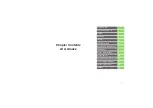
Exposure to Radio Frequency (RF) Signals
THIS MODEL DEVICE MEETS THE GOVERNMENT’S REQUIREMENTS FOR EXPOSURE TO RADIO WAVES.
Your wireless device is a radio transmitter and receiver. It is designed and manufactured not to exceed
the emission limits for exposure to radio frequency (RF) energy set by the Federal Communications
Commission of the U.S. Government. These limits are part of comprehensive guidelines and establish
permitted levels of RF energy for the general population. The guidelines are based on standards that
were developed by independent scientific organizations through periodic and thorough evaluation of
scientific studies. The standards include a substantial safety margin designed to assure the safety of all
persons, regardless of age and health.
The exposure standard for wireless mobile phones employs a unit of measurement known as the Specific
Absorption Rate, or SAR. In the United States and Canada, the SAR limit for mobile devices used by
the public is 1.6 watts/kg (W/kg) averaged over one gram of tissue. The FCC has granted an Equipment
Authorization for this wireless device with all reported SAR levels evaluated as in compliance with the
FCC RF emission guidelines. For this PV210 model, the highest SAR value when tested for use at the ear
is 0.82W/kg and when worn on the body, as described in this guide, is 1.36W/kg. SAR information for this
device is on file with the FCC and can be found under the Display Grant section of http://www.fcc.gov/
oet/fccid after searching on FCC ID: APYNAR0064 for the PV210 model
(850/900/1800/1900 MHz).
For body-worn operation, to maintain compliance with FCC RF exposure guidelines, keep the
Sidekick at least 5/8 inch (15mm) away from the body, and only use carrying cases, belt clips, or
holders that do not have metal parts and that maintain at least 5/8 inch (15 mm) separation between
the Sidekick and the body. When carrying the device on your person, it is recommended to turn the
screen display in toward the body in order to minimize RF exposure and maximize antenna efficiency.
Hearing Aid Compatibility with Mobile Phones
When some mobile phones are used near some hearing devices (hearing aids and cochlear implants),
users may detect a buzzing, humming, or whining noise. Some hearing devices are more immune than
others to this interference noise, and phones also vary in the amount of interference they generate.
The wireless telephone industry has developed ratings for some of their mobile phones, to assist hearing
device users in finding phones that may be compatible with their hearing devices. Not all phones have
been rated. Phones that are rated have the rating on their box or a label on the box.
The ratings are not guarantees. Results will vary depending on the user’s hearing device and hearing
loss. If your hearing device happens to be vulnerable to interference, you may not be able to use a rated
phone successfully. Trying out the phone with your hearing device is the best way to evaluate it for your
personal needs.
M-Ratings: Phones rated M3 or M4 meet FCC requirements and are likely to generate less interference to
hearing devices than phones that are not labeled. M4 is the better/higher of the two ratings.
T-Ratings: Phones rated T3 or T4 meet FCC requirements and are likely to be more usable with a hearing
device’s telecoil (“T Switch” or “Telephone Switch”) than unrated phones. T4 is the better/higher of the
two ratings. (Note that not all hearing devices have telecoils in them.)
Hearing devices may also be measured for immunity to this type of interference. Your hearing device
manufacturer or hearing health professional may help you find results for your hearing device. The more
immune your hearing aid is, the less likely you are to experience interference noise from mobile phones.
88 Regulatory and Compliance Information
















































